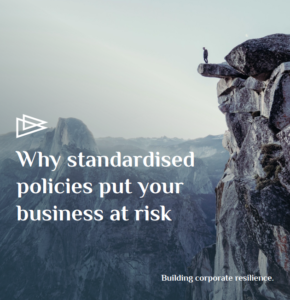
After a long period of soft cycle conditions the market is experiencing significant hardening across a broad range of lines of business and industry sectors. Rate increases, withdrawal of coverage, increasing use of exclusions and restrictions and a tougher claims environment are now commonplace experiences for policyholders.
For some, this new operating context represents an unknown. Indeed, many senior insurance buyers, brokers and underwriters haven’t experienced such challenging conditions since the early years of their careers – if at all. Perhaps even more importantly, neither have the Boards and executives they report into.
If, like many of the individuals and businesses we speak to, you are finding yourself having to justify a significant premium increase or to explain why cover is suddenly not available, you are far from alone. While that may provide some comfort it doesn’t provide you with the solutions or guidance to help you figure out what to do next.
To help, we’ve prepared a brief run down on four things to bear in mind in a hard market.
What can I expect from the hard market?
- Insurers are hit with losses that substantially exceed historically expected and priced-for levels. This can be a one-off impact or a gradual increase;
- This means risks turned out to be greater than expected and not priced-for by the actuaries in projected modelling
- Insurers will then adhere to a fourfold plan in order to return to profitability over an accelerated period to deliver results for shareholders or equity partners:
- Increase in prices
- Reductions in cover
- Denial of a greater proportion of claims in whole or in part
- Greater underwriting discipline – less interest in perceived ‘low quality’ risks
Naturally, you will expect your broker to work with you to mitigate these conditions. However, despite their best efforts, most brokers are marketing a large portfolio of risks and will find their workload vastly increased.
Four steps to taking control of the way your risks are seen by insurers
- The first and most important step is to take a proactive approach to your renewal:
- Start earlier – we recommend that you begin working six months out from renewal date.
- Set objectives – be clear about what you’re trying to achieve and what the likely outcomes will be
- Meet with as many relevant insurers as you can – building relationships and explaining your risk. You should expect face to face meetings with at least four insurers for each core class of insurance
- Focus on the detail of how your risk will be marketed. Under soft market conditions, exposures tend to be seen as a commodity; with capacity chasing risks to underwrite with less of a focus on the quality and specifics of each risk. In a hard market, this approach will come to an end as underwriters seek to instil more discipline into the way they compose and manage their book or portfolio. If your broker does not adapt to this market shift, there is nothing to distinguish your risk from anyone else’s.
- Take control of how your risks are presented to the market
- Give more than the basic information – what processes and governance do you have in place? How are you improving your risk management?
- Develop a highly detailed presentation of your suite of risks – built from the ground up – instead of simply following the proposal form approach often advocated by brokers
- Thirdly, think about how you can build a competitive and educated market for your risks:
- Consider engaging with additional brokers – encouraging them to provide market-backed proposals with agreed wordings
- Build direct relationships with insurers – helping position yourself as a ‘good’ or ‘improving’ risk and seek to build competition
- Finally, scrutinise your existing and new policy wordings:
- Ensure that they fit the real-world risks you face
- Get clarity on the boundaries of coverage and any onerous conditions
- Understand your obligations around notifications
Turning the hard market to your advantage
While a hard market cannot be avoided, it can be turned to your advantage. When rates are increasing exponentially and coverage is being withdrawn, those companies that react most quickly and most effectively can achieve a degree of competitive advantage over their peers. If you are trading within an industry that has significant insurance spend yet works to tight margins, having the right cover in place at the right price can pay significant dividends.
To find out more about how we help our clients navigate a hard market download our full guide or get in contact with the team today.
Matt Pellowe
Head of Business Development
MatthewPellowe@mactavishgroup.com




